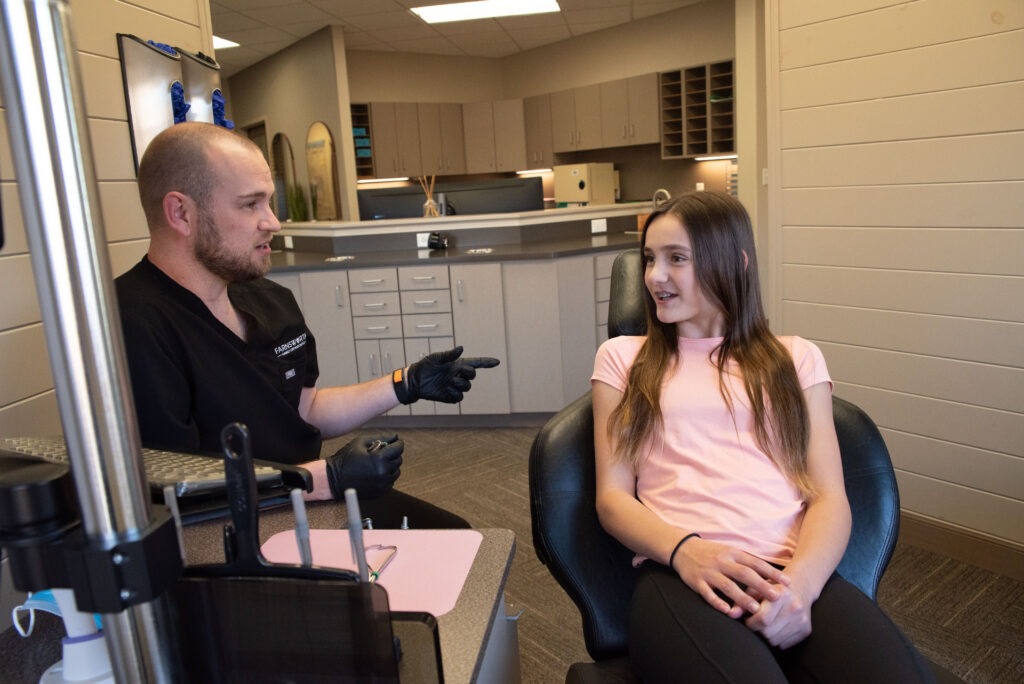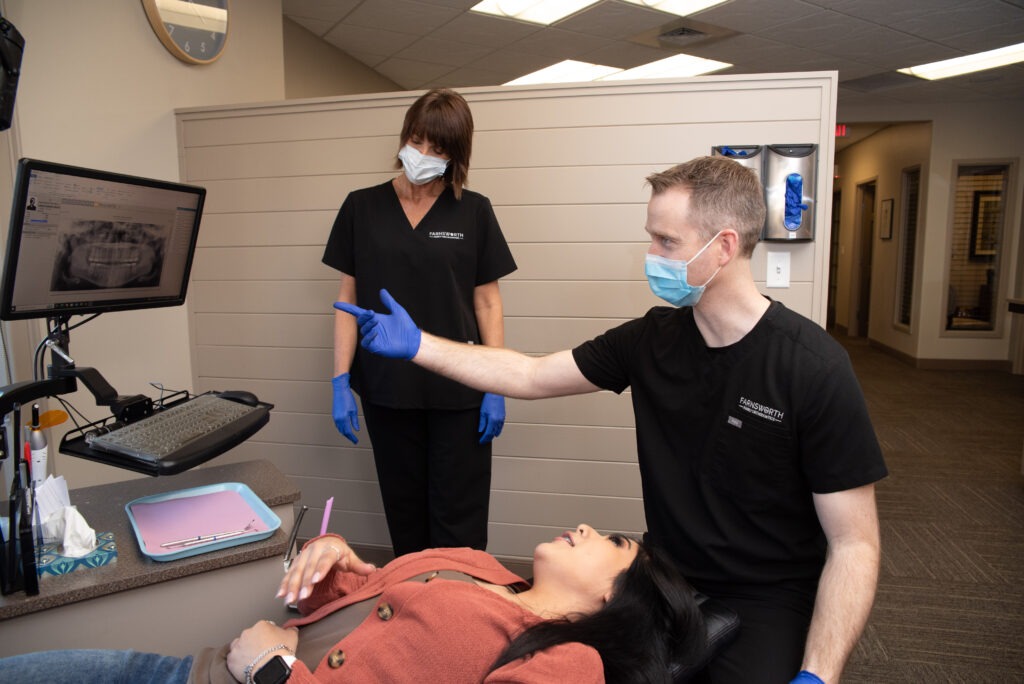Understanding the difference between an orthodontist and a dentist is essential for making informed choices about your oral health journey. At Farnsworth Family Orthodontics, we believe that educated patients make the best decisions about their oral health. Dr. Farnsworth, Dr. Sorensen, Dr. Shelley, and Dr. Brimhall, along with our dedicated team, are here to guide you through the world of dental and orthodontic care. Today, we’ll unravel the distinctions between these two professions, ensuring you have the knowledge you need to make the right decisions for your smile.
What Is a Dentist?
Dentists are highly trained professionals who specialize in diagnosing and treating a wide range of dental issues. Their primary responsibilities include:
- Routine Check-ups: Dentists conduct regular dental check-ups to assess your oral health. These visits are essential for early detection of dental problems and preventive care.
- Cleanings: Dental cleanings, often performed by dental hygienists, remove plaque and tartar buildup, helping to prevent cavities and gum disease.
- Cavity Fillings: Dentists are skilled at diagnosing and treating dental cavities (caries). They use various restorative materials, such as fillings, to repair damaged teeth.
- Oral Health Education: Dentists educate patients on proper oral hygiene practices, including brushing, flossing, and dietary choices, to maintain optimal oral health.
- X-Rays and Diagnostics: Dentists may use X-rays and other diagnostic tools to assess the condition of your teeth and identify issues not visible during a visual examination.
While dentists focus on overall oral health, including prevention and treatment of common dental issues, there are other specialized professionals who deal specifically with orthodontic concerns. Next, we’ll explore the role of orthodontists and the services they provide in more detail:
What Is an Orthodontist?
Orthodontists are highly specialized dental professionals who focus on the diagnosis, prevention, and treatment of dental and facial irregularities. Their primary role is to correct misaligned teeth and bite issues, ensuring that your teeth are not only aesthetically pleasing but also function correctly. Orthodontists offer a range of services, including:
- Braces: Orthodontists are experts in designing and applying braces, which are used to gradually shift teeth into their proper positions. Braces are effective for correcting a wide range of orthodontic issues, from crooked teeth to overbites and underbites.
- Aligners: In addition to traditional braces, orthodontists may offer clear aligner treatments. These custom-made aligners are nearly invisible and provide a more discreet way to straighten teeth.
- Retainers: After completing orthodontic treatment, patients often need retainers to maintain the new alignment of their teeth. Orthodontists provide and monitor retainers to ensure long-lasting results.
- Orthognathic Surgery: In complex cases involving severe jaw misalignments, orthodontists may work in conjunction with oral and maxillofacial surgeons to plan and perform corrective jaw surgery.
While dentists focus on general oral health care and provide a wide range of dental services, orthodontists specialize in the art of creating beautifully aligned smiles. In the next section, we’ll explore the key differences between dentists and orthodontists to help you make informed decisions about your oral health journey.
The Key Differences
- Dentists: Dentists focus on overall oral health and provide a broad spectrum of dental services. They are your primary dental care providers and address various issues, including routine check-ups, cleanings, cavity fillings, and gum health.
- Orthodontists: Orthodontists specialize exclusively in correcting misaligned teeth and bite issues. Their expertise lies in the alignment and positioning of teeth to create well-functioning and aesthetically pleasing smiles.
Education and Training:
- Dentists: Dentists typically complete four years of dental school after earning a bachelor’s degree. They obtain a Doctor of Dental Medicine (DMD) or Doctor of Dental Surgery (DDS) degree and are licensed to practice general dentistry. While they receive training in various dental procedures, their expertise is more generalized.
- Orthodontists: Orthodontists complete the same dental school education as dentists, followed by an additional two to three years of specialized orthodontic residency training. This intensive training focuses exclusively on orthodontics, including the diagnosis and treatment of complex alignment issues.

When to See a Dentist vs. an Orthodontist:
Visit your dentist for routine check-ups, cleanings, and general dental concerns. Dentists are your first point of contact for maintaining overall oral health.
Consult an orthodontist when you have specific alignment or bite issues, such as crooked teeth, overcrowding, or jaw misalignment. Orthodontists specialize in creating straight, functional smiles.
How They Work Together
Dentists and orthodontists often work together to address various aspects of your oral health. This collaborative approach ensures that all your dental needs are met effectively. Here’s how they complement each other:
- Dental Check-ups: Your regular dental check-ups with a dentist are essential for maintaining overall oral health. Dentists diagnose and treat issues like cavities, gum disease, and oral infections during these visits.
- Orthodontic Consultation: If your dentist identifies alignment or bite issues that require specialized treatment, they may refer you to an orthodontist for a consultation. Orthodontists evaluate your specific needs and develop a tailored treatment plan.
- Coordinated Care: In cases where a patient requires both general dental work and orthodontic treatment, dentists and orthodontists collaborate to ensure a seamless experience. For example, a patient may need cavity fillings or extractions before starting orthodontic treatment.
- Maintenance: After orthodontic treatment, patients may require retainers to preserve the results. Dentists play a role in monitoring oral health during this phase and providing preventive care.
The collaboration between dentists and orthodontists ensures that patients receive comprehensive oral care. This approach addresses both immediate dental needs and long-term orthodontic goals, ultimately leading to a healthy, beautiful smile.

Ready to Smile with Confidence?
In your pursuit of a healthier, more confident smile, it’s crucial to discern the roles of dentists and orthodontists. At Farnsworth Family Orthodontics, Dr. Farnsworth, Dr. Sorensen, Dr. Shelley, Dr. Brimhall, and our dedicated team are here to guide you.
For a free consultation in our welcoming clinic, complete with massage chairs and snacks, contact us today! Your journey to a brighter, more confident smile begins at Farnsworth Family Orthodontics. We’re eager to meet you and support your oral health!
